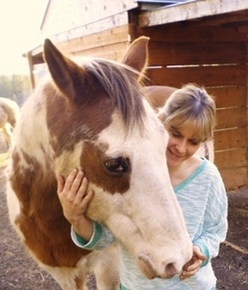Everything Matters to A Horse, including their personal space
I read this quick article today, that came in an email from the Parelli.com organization. And i said YES. I often watch people brush their horses and wonder if they are picking up on what the horse thinks of them in their personal space, touching their body. It is really the same for approaching a horse, haltering a horse, saddling a horse etc. Honestly, as creatures, they are not much different from us in how we feel in someone approaching our "comfort zone" or touching us without permission. When you look at from their point of view and are intentional, you may find it opens your mind to a whole new perspective.
Here is one example with grooming - again giving credit to the author Parelli.com
Groom with LoveIt’s time to put your grooming habits under the ‘relationship’ microscope!
For the most part, people groom their horses to make them clean and tidy, but some of the most important elements and opportunities are often missed.
In your quest to develop a positive relationship with your horse, maximize your grooming time with these perspectives and awareness:
1. Read The Body Language
We often see horses being vigorously brushed to remove dirt or detangle manes and tails and the groomer is totally oblivious to the horse’s experience. Read the body language: tossing head, ears back, tail swishing, trying to kick or bite, restless.. no wonder so many horses have to be cross-tied.
These behaviors are a sure sign that the horse is not enjoying the experience, and there are two reasons: fear or dominance.
It’s not about the dirt! It’s all about the relationship, communion and connection with your horse. Brush your horse with ‘feel’ and think about how you can make this something your horse looks forward to instead a chore for you and a 'have to' for him or her. And when you’re brushing manes and tails, start at the bottom so you don’t tear or break the hair.
3. Make It A Massage!
How can your horse look forward to grooming? Think of ways that will improve their experience. Here’s an example: Some horses are difficult around the legs and give trouble with picking up their feet when you want to clean them out. The best way to overcome this is to be less "direct line" about it, so start by massaging your horse’s legs until he or she relaxes before you ask to pick them up.
Here is one example with grooming - again giving credit to the author Parelli.com
Groom with LoveIt’s time to put your grooming habits under the ‘relationship’ microscope!
For the most part, people groom their horses to make them clean and tidy, but some of the most important elements and opportunities are often missed.
In your quest to develop a positive relationship with your horse, maximize your grooming time with these perspectives and awareness:
1. Read The Body Language
We often see horses being vigorously brushed to remove dirt or detangle manes and tails and the groomer is totally oblivious to the horse’s experience. Read the body language: tossing head, ears back, tail swishing, trying to kick or bite, restless.. no wonder so many horses have to be cross-tied.
These behaviors are a sure sign that the horse is not enjoying the experience, and there are two reasons: fear or dominance.
- A fearful horse is going to be skittish and evasive, so use more "retreat". When the horse gets uncomfortable, back off a little, slow down or pause. This will show the horse that you’re considering their point of view and will build more confidence and trust in you.
- A dominant horse is going to try and kick or bite because, in the herd environment, it’s the dominant horse that initiates grooming. If your horse is doing this with you, there’s more work to do for you as the leader! Whatever you do, don’t punish or admonish your horse. It's better to use a sense of humor, a treat or two, find the itchy spots… and sometimes even to speed up!
It’s not about the dirt! It’s all about the relationship, communion and connection with your horse. Brush your horse with ‘feel’ and think about how you can make this something your horse looks forward to instead a chore for you and a 'have to' for him or her. And when you’re brushing manes and tails, start at the bottom so you don’t tear or break the hair.
3. Make It A Massage!
How can your horse look forward to grooming? Think of ways that will improve their experience. Here’s an example: Some horses are difficult around the legs and give trouble with picking up their feet when you want to clean them out. The best way to overcome this is to be less "direct line" about it, so start by massaging your horse’s legs until he or she relaxes before you ask to pick them up.


 RSS Feed
RSS Feed
